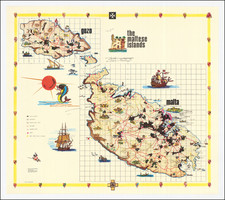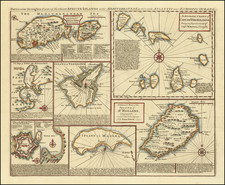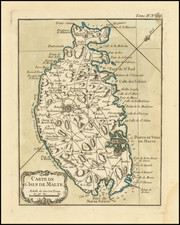De Fer's map of Malta from around 1700, with its southwest orientation, provides an intriguing lens through which to understand a significant period in the island's history. Covering Malta, Gozo, and Isle Cominotto, this map offers insights into Malta's strategic importance, its rich cultural heritage, and evolving infrastructure during the pivotal years of the late 1600s and early 1700s.
The map shows numerous churches, towers, mountains, gardens and ot her details. The Wignacourt Aqueduct, commissioned in the early 17th century, brought much-needed water to Valletta from springs in Rabat, showcasing the blend of engineering acumen and administrative foresight. The presence of numerous churches and towers on the map illustrates Malta's deeply-rooted Catholic faith.
Fort Luicien, Fort Garza, Fort de Marsiel and Fort Comino on Isle Cominotto are shown.
Valletta, with its prominent fortified city and harbor, reflects the strategic foresight of the knights. Its grid-designed streets, thick walls, and defensive towers ensured the city could withstand sieges and repel attackers.
During this period, Malta was under the sovereignty of the Knights Hospitaller, also known as the Knights of St. John. After their expulsion from Rhodes by the Ottoman Empire in 1522, the knights were granted Malta by the Holy Roman Emperor Charles V in 1530. They swiftly recognized Malta's strategic importance in the Mediterranean and began its transformation.
The Great Siege of 1565 was a defining event in this era. Ottoman forces sought to capture Malta, but the Knights, alongside the Maltese population, resisted fiercely, eventually leading to an Ottoman retreat. In the aftermath, the knights began constructing Valletta, a fortified city named in honor of Grand Master Jean Parisot de Valette, who had led the defense during the siege.
By 1700, Malta had established itself as a formidable maritime bastion under the Knights of St. John, serving as a bulwark against Ottoman incursions and piracy.










![[ Malta ] L'Isle de Malthe Possedee par les Chevaliers qui portent aujourdhuy ce nom et ou le Grand Maistre de cet Ordre fait...](https://storage.googleapis.com/raremaps/img/small/95979.jpg)

![[Malta] De Melita insula. Melita insula, ab Sicilia disiuneta Africam versus s hierosolimitanor[um] militum sedes](https://storage.googleapis.com/raremaps/img/small/73753.jpg)
![Valetta, the Capital of the Island of Malta [with] Balearic Islands [and] Corsica and Sardinia](https://storage.googleapis.com/raremaps/img/small/87300.jpg)
